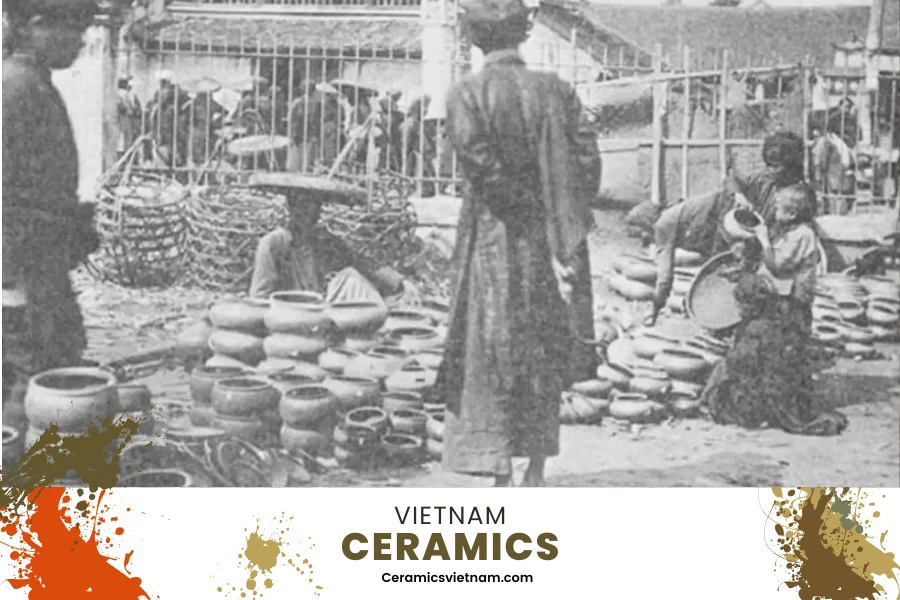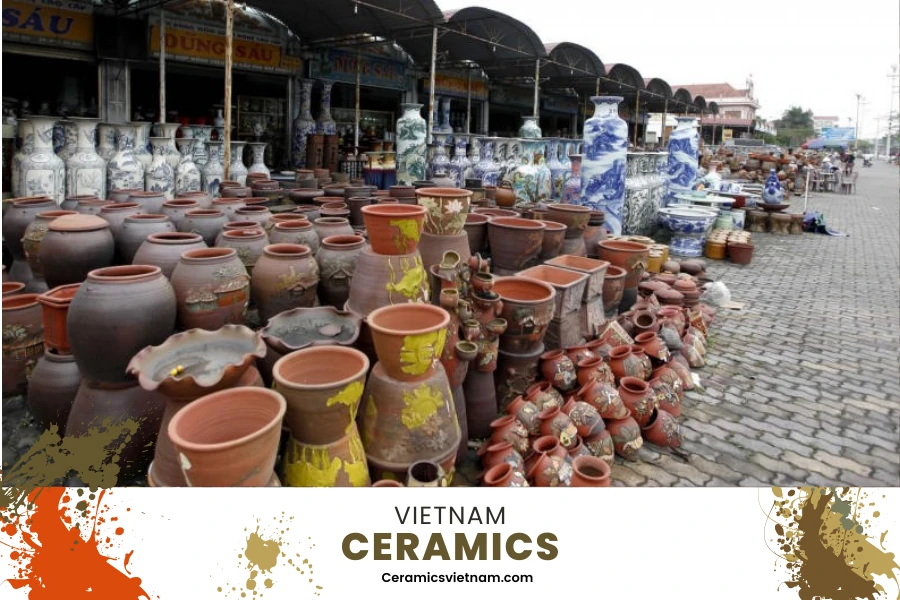Bat Trang Pottery Village, a precious gem of Vietnam’s traditional culture, sits peacefully along the banks of the Red River. This place is renowned for its exquisite ceramic products, contributing significantly to the cultural beauty of the capital with a thousand years of history. In the following article, CeramicsVietNam shares some information about where Bat Trang Pottery Village is located, as well as enjoyable experiences and shopping tips for readers to consider.
History of Bat Trang Pottery Village

What’s fun in Bat Trang pottery village? 03 fun tips for enjoying Bat Trang
According to historical documents, this pottery village was formed in the 14th-15th centuries when the Ly dynasty moved the capital from Hoa Lu to Thang Long. Artisans from the Bồ Bát village (Ninh Binh) migrated and chose the riverside land along the Red River to develop their craft. The area provided white clay, suitable for creating sophisticated ceramic products. The Bat Trang pottery village received favor and support from the Tran and Le dynasties, serving the royal families. Its ceramic products were even exported to countries like Japan, China, and Europe through maritime routes.
Although Bat Trang Pottery Village has experienced many ups and downs throughout history, it has maintained its distinctive and rich characteristics.
Location of Bat Trang Pottery Village
The question of ‘Where is Bat Trang Pottery Village?‘ is of interest to many travelers in Hanoi. After learning about the location, visitors can easily travel there for exploration.
Bat Trang Pottery Village is situated in Bat Trang commune, Gia Lam district, Hanoi. The village lies on the left bank of the Red River, approximately 15 km southeast of the city center.
You can reach the pottery village by various means such as motorcycles, cars, or buses. If driving, take the Chu Huy Man – Nguyen Van Cu – Ngoc Thuy – Duong Bridge – Bat Trang route. For bus travelers, catch bus number 47A from Long Bien and get off at the Bat Trang stop.
Now that you know where Bat Trang Pottery Village is, gather your friends and family for a visit.
Unique Products of Bat Trang Ceramic

What’s fun in Bat Trang pottery village? 03 fun tips for enjoying Bat Trang
Bat Trang ceramics are among Vietnam’s high-value artistic products.
There are various types of Bat Trang ceramics, including white ceramics, blue enamel ceramics, brown enamel ceramics, green enamel ceramics, and more. Each type features distinct colors, patterns, and shapes, reflecting the creativity and sophistication of the artisans.
Bat Trang ceramic products are not only beautiful but also highly practical, including flower vases, plant pots, tea sets, dish sets, decorative vases, and Buddha statues. You can purchase these items as souvenirs or decorations for your home.
Places to Visit in Bat Trang Pottery Village
When visiting Bat Trang Pottery Village, explore not only the ceramic products but also the beautiful and ancient spaces perfect for taking photos.
Ceramic Market
The ceramic market is where various ceramic products from Bat Trang Village are displayed. The market has a large area divided into sections for different types of products. You can find everything from classic to modern Bat Trang ceramic products, both for daily use and artistic purposes. The prices of Bat Trang ceramic products in the market are reasonable, and bargaining is possible. You can even request the sellers to print your name or engrave a picture on the ceramic products as personalized gifts.
Van Van Ancient House
Van Van Ancient House is an old house in Bat Trang Pottery Village, built in the late 18th century. The unique architectural features include two overlapping tiled roofs and two surrounding corridors. The house is adorned with various objects and paintings related to the history and culture of the pottery village. Van Van Ancient House also hosts cultural activities and exhibitions of the craft village.
Ancient Kiln
The ancient kiln is one of the oldest ceramic kilns in Bat Trang Pottery Village, constructed in the 17th century. The kiln has a round shape, about 3 meters high and 4 meters wide. It is built with white clay and covered with a layer of blue enamel to resist moisture and retain heat. The kiln is used to fire small and medium-sized ceramic products like cups, bowls, and teapots. When visiting the ancient kiln, you can observe the ceramic artisans in the firing process and gain a deeper understanding of their work.
Bat Trang Ceramic Museum

What’s fun in Bat Trang pottery village? 03 fun tips for enjoying Bat Trang
The Bat Trang Ceramic Museum is an intriguing destination located in the 5th village, Bat Trang commune. It has become an attractive check-in center for tourists, especially the younger generation. The museum features seven giant interlocking snail shells designed based on the concept of a rotating pottery wheel. The unique multi-faceted curved structure is made using local materials like fired bricks and tiles, celebrating the rustic charm of the traditional Bat Trang village. The museum not only serves as a place to introduce and preserve culture but also becomes a community activity center. It provides an interesting space for tourists to experience the manual pottery-making process and enjoy the unique cultural atmosphere.
Tips for Purchasing Bat Trang Ceramic
If you want to buy Bat Trang ceramics but are unsure how to choose high-quality and reasonably priced products, don’t worry. Gỗ Trang Trí (Decorative Wood) shares some tips for purchasing the most accurate Bat Trang ceramics.
- Learn About Different Types of Bat Trang Ceramics:
- Understand the characteristics, advantages, disadvantages, value, and uses of various types of Bat Trang ceramics, such as white ceramics, blue enamel ceramics, brown enamel ceramics, etc. This knowledge will help you choose the type of ceramic that suits your needs and preferences.
- Compare Prices and Quality:
- Do not rush to buy ceramic products that look beautiful or cheap. Visit multiple stores or selling areas to examine and compare the prices and quality of Bat Trang ceramic products. Pay attention to details such as shape, pattern, color, gloss, thickness, hardness, and durability.
- Negotiate Prices and Request Warranty:
- Be aware that the prices of Bat Trang ceramic products do not have a fixed range and depend on factors like the type of ceramic, size, shape, pattern, and quality. Therefore, you can negotiate prices with the sellers to get the most reasonable price. Also, inquire about warranties or guarantees for the purchased ceramics.
- Purchase from Reputable Stores or Directly from Workshops:
- Avoid buying Bat Trang ceramics from unclear or unverified sources. Choose to buy from reputable stores or directly from the workshops in the craft village. This ensures the authenticity and quality of the ceramics.
Local Cuisine at Bat Trang Pottery Village
Bat Trang Village is not only famous for its ceramic products and ancient spaces but also for its traditional and delicious local dishes that everyone should try. When thinking of Bat Trang, people not only ask ‘Where is Bat Trang Pottery Village?‘ but also inquire about the local cuisine.
Squid Bamboo Shoot Soup

What’s fun in Bat Trang pottery village? 03 fun tips for enjoying Bat Trang
Squid bamboo shoot soup is one of the particularly traditional specialties of the locals, an essential dish in their daily meals. Cooking this soup requires meticulous care, especially in preparing bamboo shoots and selecting small-sized squid, almost like toothpicks. To ensure the best flavor, the choice of ingredients must be thorough and careful. Notably, this soup also includes beaten eggs placed on top to prevent the dish from having a fishy smell. When serving, the bowl of squid bamboo shoot soup has a golden color, clear broth, and a sweet lingering taste. When enjoyed, the squid offers a uniquely crisp and delicious sensation, creating an irresistible flavor.
Jute Mallow Stir-Fried with Dried Squid
In addition to squid bamboo shoot soup, jute mallow stir-fried with dried squid is a flavorful dish that you should not miss when visiting the Bat Trang craft village. To create the characteristic fresh taste, the dried squid must be Thanh Hoa squid, providing a distinct deliciousness and aroma. Furthermore, it is advisable to choose female squid to ensure a tender texture. After removing the outer skin of the squid, boil it in boiling water at about 40 degrees Celsius, then rinse it thoroughly.
Next, the jute mallow needs to be shredded into small fibers, squeezed to remove water, and mixed with dried squid. You can add pepper and cilantro to enhance the distinctive flavor of this dish.
Bat Trang Pottery Village offers not only a glimpse into the intricate world of ceramics but also an opportunity to immerse yourself in the rich history and culture of Vietnam. From exploring the market and ancient houses to witnessing the traditional kilns and museums, your visit to Bat Trang will be a memorable experience. Additionally, savoring the local cuisine adds another layer to the vibrant tapestry of this cultural gem.













Leave a reply